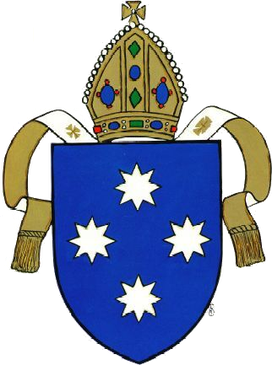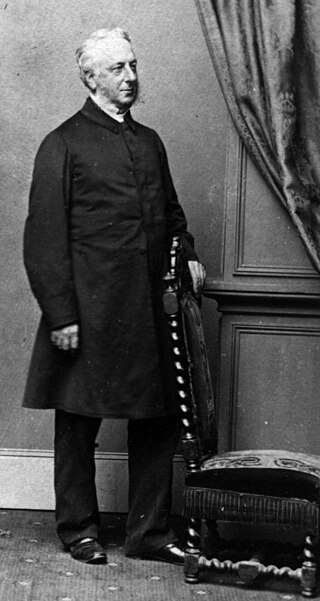Related Research Articles

Young Talent Time is an Australian television variety program produced by Lewis-Young Productions and screened on Network Ten. The original series ran from 1971 until 1988 and was hosted by singer-songwriter and record producer Johnny Young for its entire run. The show was briefly revived by Network Ten in 2012 and was hosted by singer and actor Rob Mills.

The Sydney Morning Herald (SMH) is a daily tabloid newspaper published in Sydney, Australia, and owned by Nine Entertainment. Founded in 1831 as the Sydney Herald, the Herald is the oldest continuously published newspaper in Australia and claims to be the most widely read masthead in the country. It is considered a newspaper of record for Australia.

The Diocese of Sydney is a diocese in Sydney, within the Province of New South Wales of the Anglican Church of Australia. The majority of the diocese is evangelical and low church in tradition.

St James' Church, commonly known as St James', King Street, is an Australian heritage-listed Anglican parish church located at 173 King Street, in the Sydney central business district in New South Wales. Consecrated in February 1824 and named in honour of St James the Great, it became a parish church in 1835. Designed in the style of a Georgian town church by the transported convict architect Francis Greenway during the governorship of Lachlan Macquarie, St James' is part of the historical precinct of Macquarie Street which includes other early colonial era buildings such as the World Heritage listed Hyde Park Barracks.

St John the Baptist Anglican Church is an active Anglican church located between Alt and Bland Streets, Ashfield, a suburb of Sydney, New South Wales, Australia. Founded in 1840, on land donated by Elizabeth Underwood, the church building is the oldest authenticated surviving building in Ashfield, having been built at the time when subdivision increased the population density sufficiently to turn Ashfield into a town. It was also the first church built along the Parramatta Road which linked the early colonial towns of Sydney and Parramatta. The earliest remaining parts of the building are one of the first Sydney designs by the colonial architect Edmund Blacket, who later became renowned for his ecclesiastical architecture.
Andrew John Refshauge is a former Australian politician who was Deputy Premier of New South Wales from 1995 to 2005, a member of the New South Wales Legislative Assembly between 1983 and 2005, and a senior minister in the Carr ministry.

Australia participated at the 1986 Commonwealth Games in Edinburgh, Scotland in 24 July and 2 August 1986.. It was Australia's thirteenth appearance at the Commonwealth Games, having competed at every Games since their inception in 1930. Australia won medals in eleven of the eleven sports that it entered

Christ Church St Laurence is an Anglican church located at 814 George Street, near Central railway station and Haymarket, in Sydney, New South Wales, Australia. It is the principal centre of Anglo-Catholic worship in the city and Diocese of Sydney, where the Anglicanism is predominantly Evangelical in character. Anglo-Catholicism is manifested at Christ Church St Laurence by an emphasis on the sacraments, ritual, music and social action, all of which have been prominent features of Anglo-Catholicism since the 19th century.
The following lists events that happened during 1831 in Australia.

Robert Lionel Seddon was an English international rugby union forward who played club rugby for Broughton Rangers and Swinton and county rugby for Lancashire. Seddon was capped at international level for both England and the British Isles. Seddon played three matches for England in 1887, and in 1888 was one of only four capped players to represent Britain in the 1888 tour of New Zealand and Australia. Seddon was given the captaincy of the British team, but died in a boating accident halfway through the tour. Seddon and the British team were honoured in 2013 with induction into the IRB Hall of Fame.
Paul Broughton was an Australian rugby league footballer, coach and club chief executive. He was the Chairman of the Gold Coast Titans in the NRL. He also served on the board of the North Queensland Cowboys. He has been described by some as an Australian rugby league football identity.
Commonwealth Film Laboratories was an Australian production company that operated from 1925 to the 1950s. It was formerly located in Surry Hills, Sydney.
Murcheson Creek is a 1976 Australian television film which was a feature-length pilot for an unmade TV series.
True Believers is a 1988 Australian miniseries which looks at the history of the Australian Labor Party from the end of World War II up to the Australian Labor Party split of 1955.
Matthew and Son is a 1984 Australian television film about a single parent who is a police surgeon. It was filmed May to June 1984 and is a pilot for a TV series that never eventuated.
Trial of Ned Kelly is a 1977 Australian TV film about the trial of Ned Kelly.
Ernest Clement Vernon Broughton was a politician in New South Wales, Australia. He was a Member of the New South Wales Legislative Assembly and a mayor of the Municipality of Ashfield.

The Garrison Church is a heritage-listed active Anglican church building located at Argyle Street in the inner city Sydney on the edge of the suburb of Millers Point in the City of Sydney local government area of New South Wales, Australia. It was designed by Henry Ginn, Edmund Blacket and built from 1840 to 1846 by Edward Flood and George Patton. It is also known as Holy Trinity Anglican Church and Hall. The property is owned by Anglican Church Property Trust and was added to the New South Wales State Heritage Register on 2 April 1999.
Cindy Heydon is an Australian former soccer player who played for the Australia women's national soccer team between 1978 and 1984.

William Horatio Walsh was a High Church Anglican priest in Australia and England.
References
- ↑ Ed. Scott Murray, Australia on the Small Screen 1970-1995, Oxford Uni Press, 1996 p30
- ↑ "Cindy What a Right Twit". Sydney Morning Herald. 6 May 1984. p. 7.